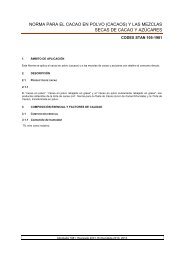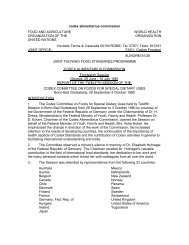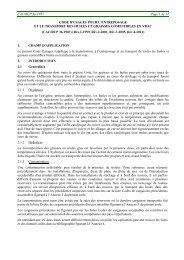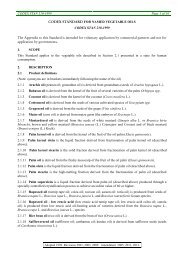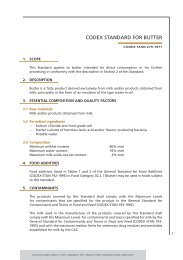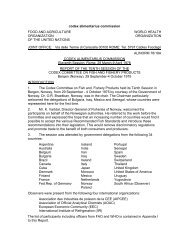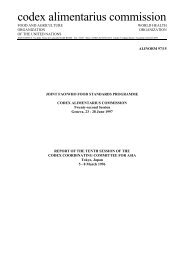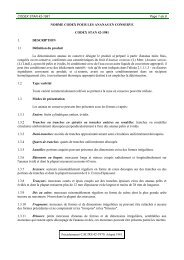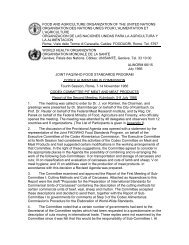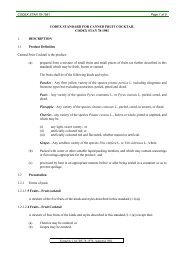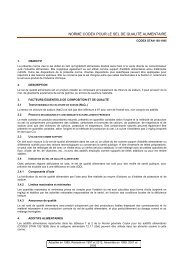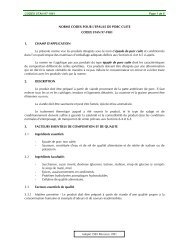REP13/FH JOINT FAO/WHO FOOD STANDARDS PROGRAMME ...
REP13/FH JOINT FAO/WHO FOOD STANDARDS PROGRAMME ...
REP13/FH JOINT FAO/WHO FOOD STANDARDS PROGRAMME ...
You also want an ePaper? Increase the reach of your titles
YUMPU automatically turns print PDFs into web optimized ePapers that Google loves.
<strong>REP13</strong>/<strong>FH</strong> 10<br />
PROPOSED DRAFT ANNEX ON BERRIES TO THE CODE OF HYGIENIC PRACTICE FOR FRESH<br />
FRUITS AND VEGETABLES (CAC/RCP 53-2003) (Agenda Item 7) 11<br />
86. The Committee recalled that the 43 rd Session agreed to request the 35 th Session of the Commission to<br />
approve new work on the development of an Annex on berries to the Code of Hygienic Practice for Fresh<br />
Fruits and Vegetables (CAC/RCP 53-2003) and to establish an electronic working group, led by Brazil, to<br />
develop the proposed draft Annex for comments at Step 3 and consideration by the present Session.<br />
87. The Delegation of Brazil introduced the report of the electronic working group (CX/<strong>FH</strong> 12/44/9) and<br />
highlighted the approach taken in the development of the Annex. He pointed out that special attention<br />
should be given to the scope and the definition of berries and recommended that the entire Code and all its<br />
annexes be reviewed to ensure consistency and remove duplication (Agenda Item 8). Therefore, he<br />
recommended that the Committee should not pay too much attention to the consistency and duplication with<br />
the main text and/or other annexes at this time.<br />
88. The Committee considered the proposed draft Annex section by section and, in addition to editorial<br />
corrections, made the following comments and amendments.<br />
Introduction<br />
89. In the third paragraph, “manipulation” was replaced by “handling” as more correct.<br />
Scope<br />
90. The Committee agreed to limit the scope to all varieties of edible strawberries, raspberries,<br />
blackberries, mulberries, blueberries, currants and gooseberries and groundcherries that would be indicated<br />
also by their scientific name to avoid confusion, as common names differed from country to country. In view<br />
of this decision, it was agreed that there was no need for a definition for berries in section 2.3.<br />
91. The Committee further agreed to clarify that in the case of wild berries, only the measures for handling<br />
and post-harvest activities apply.<br />
3.1.1 Location of the production site<br />
92. The second paragraph was amended to clarify cleaning and disinfection steps and to state that berries<br />
that have come into contact with flood waters should not be used because of the high risk of contamination.<br />
93. The Committee agreed to amend the third paragraph to allow flexibility for a drying period before<br />
harvesting.<br />
3.1.2 Wild and domestic animals and human activity<br />
94. The Committee agreed to refer to wild and domestic animals and not to list specific examples.<br />
95. In the first bullet point, it was agreed to replace “cultural” by “cultivation” as this was a more<br />
understandable and common term”, and to refer only to environmental protection regulations, as this would<br />
encompass both animal and plant.<br />
3.2 Hygienic primary production of berries<br />
96. The section was amended by the addition of examples to clarify those production practices that could<br />
minimize contact with airborne contaminants.<br />
97. The last paragraph was amended to provide examples of biodegradable materials used during<br />
growing and harvesting by small farmers.<br />
3.2.1.1 Water for primary production<br />
98. The Committee agreed to delete the second bullet point and to insert guidance on selection of<br />
indicators as the selection of indicators should be fit for purpose and not limited to E. coli testing.<br />
3.2.1.2 Manure, biosolids and other natural fertilizers<br />
99. The Committee did not agree to a proposal to delete “to the extent possible” in the first sentence as<br />
this would prevent the use of manure (untreated and liquid). It was noted that manure was used, in particular<br />
for organic agriculture, and that general guidance on the use of manure was provided in the main Code<br />
(section 3.2.1.2).<br />
11<br />
CX/<strong>FH</strong> 12/44/9; comments of Costa Rica, Cuba, Egypt, Japan, Malaysia, Mexico and USA (CX/<strong>FH</strong> 12/44/9-Add.1);<br />
Argentina, Philippines, Senegal and IACFO (CX/<strong>FH</strong> 12/44/9-Add.2); Thailand (CRD 4); India (CRD 5); EU (CRD 15);<br />
Brazil (CRD 18).



